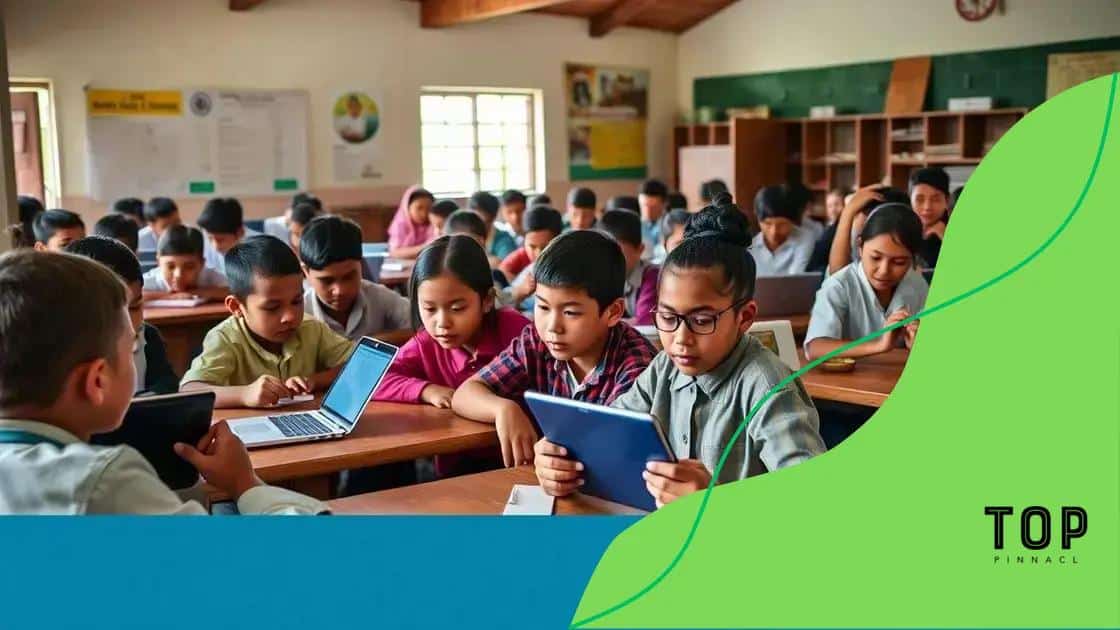Digital equity grants for rural schools: bridging the gap
Digital equity grants for rural schools provide essential funding to enhance access to technology and improve educational outcomes, ensuring all students have equal opportunities to thrive in a digital world.
Digital equity grants for rural schools are reshaping the educational landscape by providing much-needed resources to underserved communities. Have you considered how these initiatives can uplift learning experiences for students?
Understanding digital equity grants
Understanding digital equity grants is essential for ensuring that all students have access to the tools they need for success. In today’s world, technology plays a huge role in learning, and these grants are designed specifically to address the gaps in resources.
What are Digital Equity Grants?
Digital equity grants are funds provided to schools and educational organizations. Their purpose is to improve access to technology and the internet, especially in underserved areas. This means more devices, better internet connections, and resources to support teachers and students alike.
Key Features of Digital Equity Grants
- Funding for hardware like laptops and tablets
- Support for internet connectivity in rural locations
- Professional development for educators to use technology effectively
These grants not only provide equipment but also support training for staff. When teachers can use technology confidently, it directly impacts student learning.
Additionally, digital equity grants aim to create a level playing field. Schools that receive these grants often see improvements in student engagement and achievement. By integrating technology into the classroom, students can access a wealth of online resources.
Many organizations and government entities offer these grants, targeting different needs. For instance, some focus specifically on providing devices for students, while others might prioritize connectivity.
Ultimately, the goal of these initiatives is to ensure every student, regardless of their background, has the opportunity to thrive in a digital age.
Benefits of digital equity for rural schools
The benefits of digital equity for rural schools are immense and transformational. By providing access to technology, these schools can bridge the educational divide between urban and rural areas.
Enhanced Learning Opportunities
With digital resources, students gain access to a variety of learning materials. Online courses, interactive platforms, and digital libraries become available, allowing students to learn at their own pace. This exposure helps to expand their knowledge and skills beyond traditional textbooks.
Improved Teacher Resources
Not only do students benefit, but teachers also gain valuable tools. Professional development programs help educators learn how to integrate technology into their teaching. This not only enhances their skills but also improves classroom engagement.
- Access to online training workshops
- Collaboration tools for lesson planning
- Resources to track student performance
These advancements empower teachers to create innovative lesson plans that capture student interest, making learning more relevant and exciting.
Another important aspect is fostering collaboration among students. With technology, students can work together on projects, share ideas, and learn from each other, regardless of their physical location. This collaboration builds vital social skills and teamwork.
Furthermore, increased access to technology prepares students for future careers. In today’s world, digital skills are essential. By integrating these skills into education, rural schools ensure that students are competitive and ready for the workforce.
Overall, digital equity plays a crucial role in improving the educational landscape in rural areas, fostering growth and opportunity for both students and teachers alike.
Success stories from funded schools

Many schools have experienced remarkable transformation through funding from digital equity grants. These success stories highlight the positive impact that technology can have on education, especially in rural areas.
Case Study: Maplewood High School
At Maplewood High School, the introduction of tablets and reliable internet access has changed the learning environment. Students can now participate in online classes and access up-to-date resources instantly. This accessibility has led to improved performance in science and math, with students showing greater interest and engagement.
Innovative Programs in Pine Valley Elementary
Pine Valley Elementary has also made strides thanks to these grants. The school developed an after-school program focusing on digital literacy. Students not only learn how to use technology but also how to create projects that benefit their community. Many students have expressed newfound confidence in their abilities.
- Increased student participation in classes
- Higher test scores and improved grades
- Enhanced collaboration between students and teachers
These initiatives encourage teamwork and critical thinking, crucial skills in our digital age. As students work together, they gain experience that will serve them well in future endeavors.
Furthermore, rural schools have formed partnerships with local businesses and organizations. This collaboration has resulted in internships and real-world learning experiences, further connecting education with the community. Students are now more prepared for their future careers, thanks to the practical skills they acquire.
In conclusion, the success stories from funded schools offer hope and inspiration. They demonstrate how digital equity grants not only enhance learning but also empower entire communities.
How to apply for digital equity grants
Applying for digital equity grants may seem challenging at first, but with the right approach, it can be straightforward. Understanding the application process is crucial for success.
Identify the Right Grant Opportunities
Start by researching different grants available for your school or organization. Many foundations and government agencies offer funding aimed at improving technology access in rural areas. Pay attention to their objectives and see which align with your needs.
Gather Necessary Documentation
Once you identify potential grants, prepare the necessary documentation. This often includes a detailed description of your school, the population you serve, and how the funds will enhance digital equity. You should also gather statistics and information to support your application.
- Current technology resources available
- Student demographics and needs
- Plans for implementing technology improvements
These details will help grant reviewers understand the impact of the funding on your students.
Next, create a clear and compelling narrative. Your application should outline how the digital equity grant will address specific challenges in your school. Explain how the funds will support both teachers and students in using technology effectively.
Additionally, it’s beneficial to outline your plan for evaluating the success of the grant. Describe how you will measure the impact of the new technology on student learning and engagement.
Submit Your Application
After finalizing your application, review all components thoroughly. Ensure all forms are complete and deadlines are met. Submit your application as per the guidelines provided.
Lastly, follow up with the funding organization if possible. This demonstrates your interest and can help clarify any questions they might have about your application.
Future of technology in rural education
The future of technology in rural education looks promising as innovations continue to reshape the learning landscape. As technology becomes more accessible, rural schools are poised to benefit immensely.
Adoption of Advanced Learning Tools
With the help of digital equity grants, schools can adopt new learning tools. This includes interactive software and online resources that engage students in meaningful ways. Virtual reality (VR) is becoming more popular, providing immersive experiences that bring subjects like science and history to life.
Increased Connectivity and Collaboration
Improvements in internet connectivity are crucial for rural areas. As robust networks expand, students will have better access to online courses and educational materials. This connectivity enables collaboration with peers from different regions, allowing for diverse perspectives and shared learning experiences.
- Virtual classrooms that connect students globally
- Access to expert educators through teleconferencing
- Collaboration projects across various schools
Such collaborations not only enhance learning but also prepare students for a global workforce. Engaging with different cultures and ideas is vital in today’s interconnected world.
Furthermore, artificial intelligence (AI) is likely to play a larger role in personalizing education. AI can analyze student performance and provide tailored resources, ensuring that each learner receives the support they need to succeed. This adaptability can greatly improve student outcomes.
Finally, the integration of technology in rural education encourages lifelong learning. Students can develop skills that will serve them well in future careers, including critical thinking and digital literacy. Preparing students for the jobs of tomorrow is essential for a thriving economy.
The integration of technology in rural education offers a brighter future for students and communities. By embracing digital equity grants, schools can enhance learning experiences and ensure that every child has the resources they need to succeed. Access to advanced tools and improved connectivity allows students to engage more deeply, explore new ideas, and prepare for the demands of the modern workforce. As we move forward, the role of technology in education will continue to grow, paving the way for innovation and collaboration that enriches the lives of young learners.
FAQ – Frequently Asked Questions about Digital Equity Grants for Rural Schools
What are digital equity grants?
Digital equity grants provide funding to improve access to technology and the internet in underserved schools, particularly in rural areas.
How can schools apply for these grants?
Schools can apply by researching available grants, gathering necessary documentation, and submitting a compelling proposal that outlines their needs.
What benefits do students gain from digital equity?
Students benefit from enhanced learning opportunities, improved engagement, personalized education, and better preparation for future careers.
How does technology improve teaching in rural schools?
Technology provides teachers with tools for collaboration, innovative teaching methods, and access to professional development resources, improving the overall learning environment.






